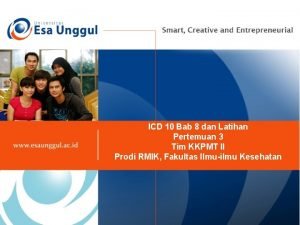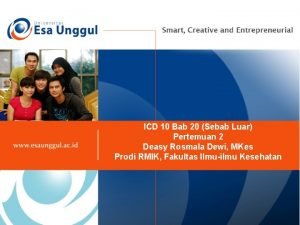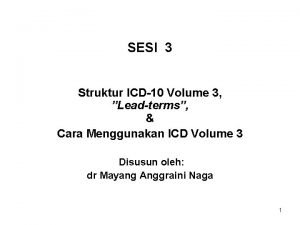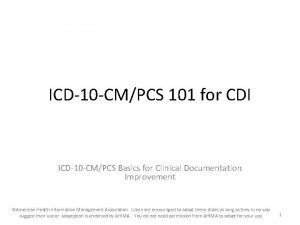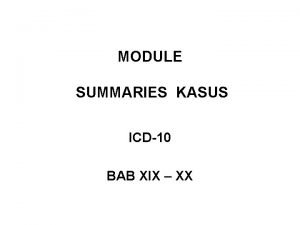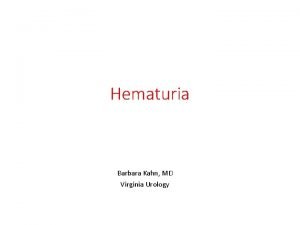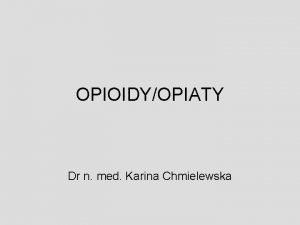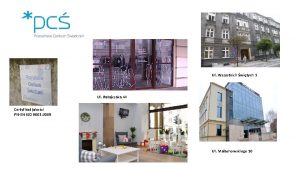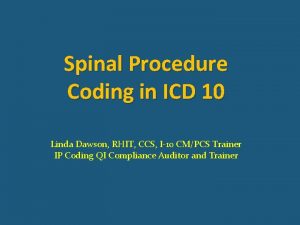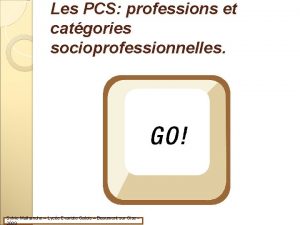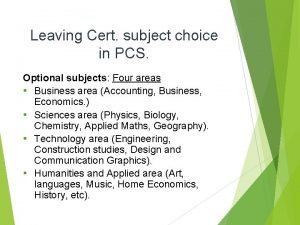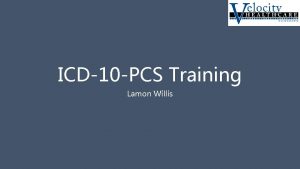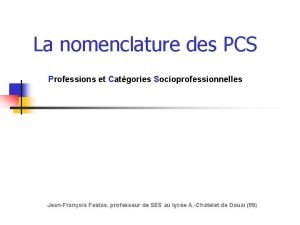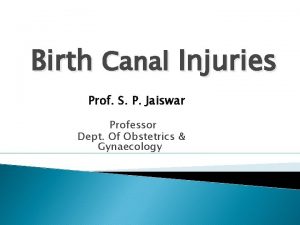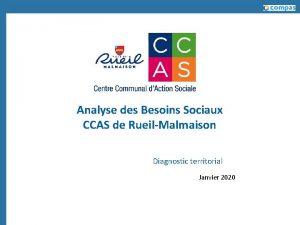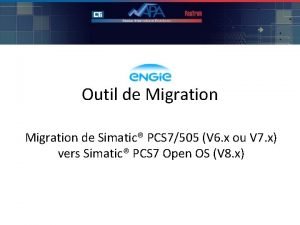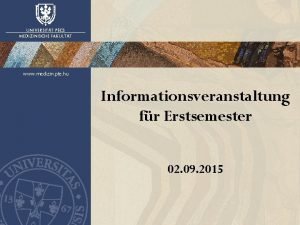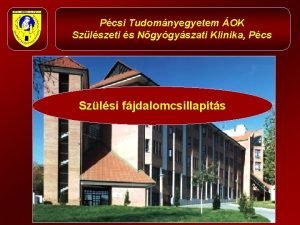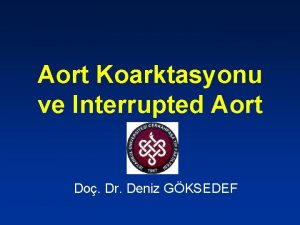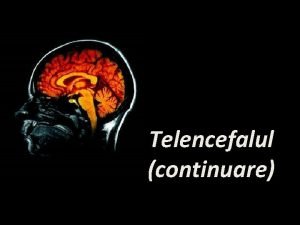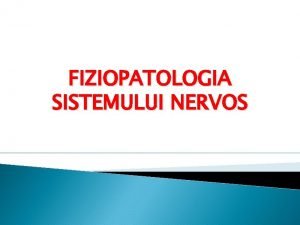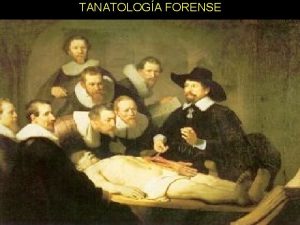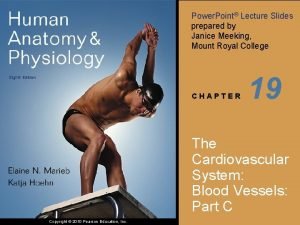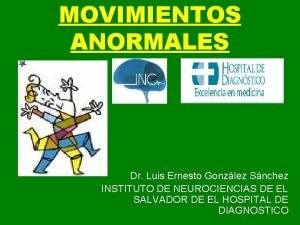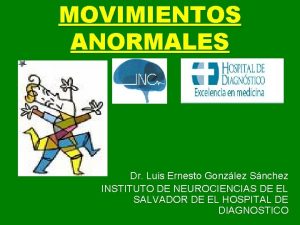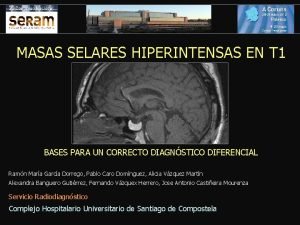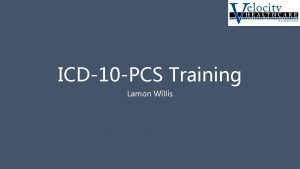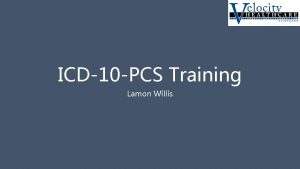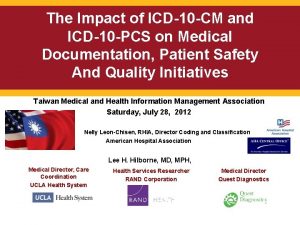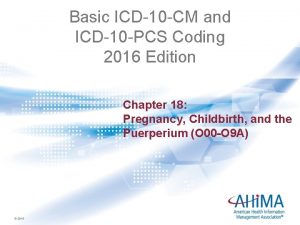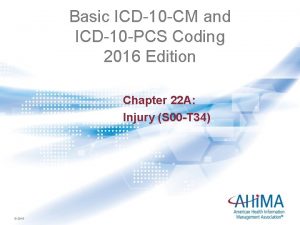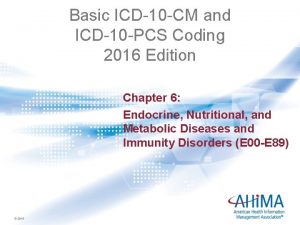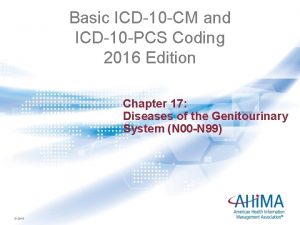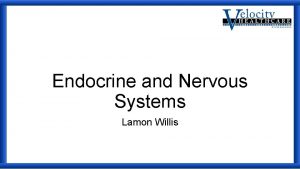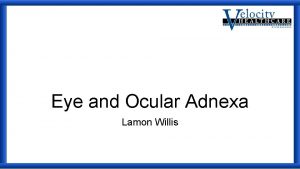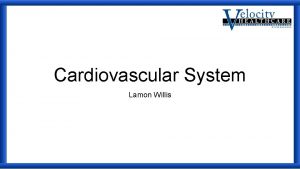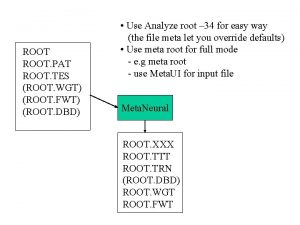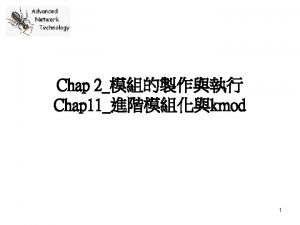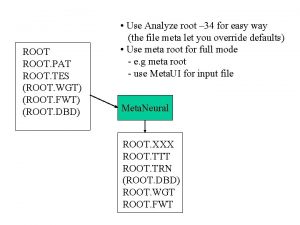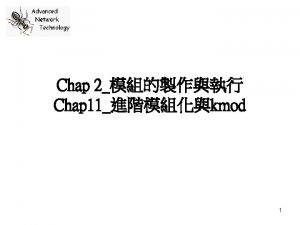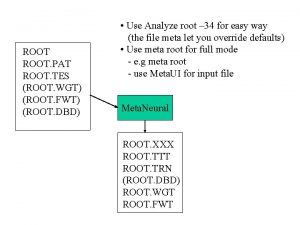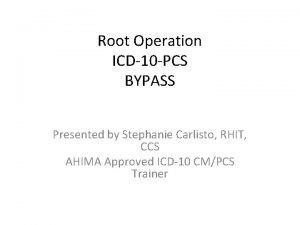ICD10 PCS Training Lamon Willis Root Operations which




























































- Slides: 60

ICD-10 -PCS Training Lamon Willis

Root Operations which take out Solids, Fluids, or Gases from a Body Part

Root Operations which take out Solids, Fluids, or Gases from a Body Part

Drainage (9) Drainage 9 Definition Taking or letting out fluids and/or gases from a body part Explanation The qualifier Diagnostic is used to identify drainage procedures that are biopsies Examples Thoracentesis, incision and drainage, Aspiration, Lumbar puncture • Used for both Diagnostic and Therapeutic procedures • 6 th character—Device

Extirpation (C) Extirpation C Definition Taking or cutting out solid matter from a body part Explanation The solid matter may be an abnormal byproduct of a biological function or a foreign body; it may be imbedded in a body part, or in the lumen of a tubular body part. The solid matter may or may not have been previously broken into pieces. Examples Thrombectomy, endarterectomy, choledocholithotomy, excision foreign body

Extirpation • Extirpation represents a range of procedures where the body part itself is not the focus of the procedure. • Instead, the objective is to remove solid material such as a foreign body, thrombus, or calculus from the body part.

Fragmentation (F) Fragmentation F Definition Breaking solid matter in a body part into pieces Explanation Physical force applied directly or indirectly is used to break the solid matter into pieces. The solid matter may be an abnormal byproduct of a biological function or a foreign body. The pieces of solid matter are not taken out. Examples Extracorporeal shockwave lithotripsy, transurethral lithotripsy

Fragmentation (F) • Fragmentation is coded for procedures to break up, but not remove, solid material such as a calculus or foreign body. • This root operation includes both direct and extracorporeal Fragmentation procedures.

Quiz • The patient is being evaluated for septic arthritis of the right knee. A needle arthrocentesis was performed on the right knee with 15 cc of fluid being removed. • Code(s): ___________

Quiz • The patient is being evaluated for septic arthritis of the right knee. A needle arthrocentesis was performed on the right knee with 15 cc of fluid being removed. • Code(s): ___________

Answer

Quiz • A staghorn calculus of the right renal pelvis was treated five days ago by lithotripsy. During this encounter the calculus pieces are removed via a percutaneous nephrostomy tube. • Code(s): ___________

Answer

Quiz • The patient was placed in the supine position and in the F 2 focus of the MSL 5000 lithotriptor. Shock wave lithotripsy was begun at 17 k. V and progressed to 23. A total of 3, 000 shocks were given to the stone with resultant fragmentation of the calculus in the left renal pelvis. • Code(s): _________

Answer

Root Operations Involving Cutting or Separation Only

Root Operations Involving Cutting or Separation Only

Division (8) Division 8 Definition Cutting into a body part without draining fluids and/or gases from the body part in order to separate or transect a body part Explanation All or a portion of the body part is separated into two or more portions Examples Spinal cordotomy, osteotomy, neurotomy, episiotomy .

Division (8) • The root operation Division is coded when the objective of the procedure is to cut into, transect, or otherwise separate all or a portion of a body part. • When the objective is to cut or separate the area around a body part, the attachments to a body part, or between subdivisions of a body part that are causing abnormal constraint, the root operation Release is coded instead.

• Cut the body Division part • Free the Release body part

Division (8) versus Release (N) Coding Guideline B 3. 14. Release vs. Division If the sole objective of the procedure is freeing a body part without cutting the body part, the root operation is Release. If the sole objective of the procedure is separating or transecting a body part, the root operation is Division.

Division (8) versus Release (N) Coding Guideline B 3. 14. Release vs. Division Examples: • Freeing a nerve root from surrounding scar tissue to relieve pain is coded to the root operation Release. • Severing a nerve root to relieve pain is coded to the root operation Division.

Release (N) Release N Definition Freeing a body part from an abnormal physical constraint by cutting or by use of force Explanation Some of the restraining tissue may be taken out but none of the body part is taken out Examples Adhesiolysis, carpal tunnel release, manipulation of joint adhesions

Release (N) • Release procedures are coded to the body part being freed. • The procedure can be performed: • on the area around a body part, • on the attachments to a body part, or • between subdivisions of a body part that are causing the abnormal constraint.

Release (N) Coding Guideline B 3. 13. Release Procedures In the root operation Release, the body part value coded is the body part being freed and not the tissue being manipulated or cut to free the body part. Example: • Lysis of intestinal adhesions is coded to the specific intestine body part value.

Quiz • A patient is being treated for a cumulative injury resulting in a frozen left shoulder. The patient has been unresponsive to exercise and medication. An arthroscopic manipulation is performed to release the frozen shoulder. • Code(s): ________

Answer

Quiz • The patient has bilateral flexion contractures of the knees at 45 degrees. Posterior capsulotomy via incision was performed on both knees. • Code(s): ______________

Answer

Answer

Quiz • In preparation for an impending delivery, the physician performs a midline episiotomy. • Code(s): _________

Answer

Quiz • Percutaneous osteotomy of the capitate and lunate bones, right hand. • Code(s): _______________

Answer

Answer

Knowledge of anatomy and diagrams are keys to successful PCS coding.

Root Operations That Put In/ Put Back or Move Some/All of a Body Part

Root Operations That Put In/ Put Back or Move Some/All of a Body Part

Transplantation (Y) Transplantation Y Definition Putting in or on all or a portion of a living body part taken from another individual or animal to physically take the place and/or function of all or a portion of a similar body part Explanation The native body part may or may not be taken out, and the transplanted body part may take over all or a portion of its function Examples Kidney transplant, heart transplant

Transplantation (Y) • A small number of procedures is represented in the root operation Transplantation and includes only the body parts currently being transplanted. • Go to Transplantation in Index • Cornea and heart valve go to Replacement • Bone marrow transplant goes to Administration Section • Qualifier values specify the genetic compatibility of the body part transplanted

Transplantation (Y) Coding Note: Bone Marrow Transplant Bone marrow transplant procedures are coded in section 3, Administration, to the root operation 2, Transfusion

Qualifier Values for Transplantation Allogeneic Syngeneic Zooplastic

Qualifier Choices Type of Transplant Qualifier Character Definition Allogeneic 0 Taken from different individuals of the same species Syngeneic 1 Having to do with individuals or tissues that have identical genes, such as identical twins Zooplastic 2 Tissue from an animal to a human

Coding Tip • PCS does not include corneas and heart valves in the root operation Transplantation. • Even though sometimes referred to as a transplant, the cornea graft is a layer of corneal tissue and not considered a body part in the same way that complex structures like lung, liver, and kidney are. • Corneas and heart valves are classified to Replacement in PCS.

Transplantation (Y) Coding Guideline B 3. 16. Transplantation vs. Administration • Putting in a mature and functioning living body part taken from another individual or animal is coded to the root operation Transplantation. Putting in autologous or nonautologous cells is coded to the Administration section. • Example: Putting in autologous or nonautologous bone marrow, pancreatic islet cells, or stem cells is coded to the Administration section.

Reattachment (M) Reattachment M Definition Putting back in or on all or a portion of a separated body part to its normal location or other suitable location Explanation Vascular circulation and nervous pathways may or may not be reestablished Examples Reattachment of hand, reattachment of avulsed kidney, reattachment of finger

Reattachment (M) • Procedures coded to Reattachment include putting back a body part that has been cut off or avulsed. • Nerves and blood vessels may or may not be reconnected in a Reattachment procedure. • Coding Note: Free grafts are coded to the root operation of Replacement.

Transfer (X) Transfer X Definition Moving, without taking out, all or a portion of a body part to another location to take over the function of all or a portion of a body part Explanation The body part transferred remains connected to its vascular and nervous supply Examples Tendon transfer, skin pedicle flap transfer, skin transfer flap

Transfer (X) Coding Note: Body System Value For procedures involving transfer of tissue layers such as skin, fascia and muscle, the procedure is coded to the body system value that describes the deepest tissue layer in the flap. When the tissue transferred is composed of more than one tissue layer, the qualifier can be used to describe the other tissue layers, if any, being transferred. For transfer procedures classified to other body systems such as peripheral nervous system, the body part value specifies the body part that is the source of the transfer ("from"). Where qualifiers are available, they specify the destination of the transfer ("to").

Transfer (X) Coding Note: Free grafts are coded to the root operation of Replacement The root operation Transfer is used to represent procedures where a body part is moved to another location without disrupting its vascular and nervous supply. In the body systems that classify the subcutaneous tissue, fascia, and muscle body parts, a qualifier is used to specify when more than one tissue layer was used in the transfer procedure, such as musculocutaneus flap transfer.

Reposition (S) Reposition S Definition Moving to its normal location or other suitable location all or a portion of a body part Explanation The body part is moved to a new location from an abnormal location, or from a normal location where it is not functioning correctly. The body part may or may not be cut or off to be moved to the new location Examples Reposition of undescended testicle, fracture reduction

Reposition (S) • Reposition represents procedures for moving a body part to a new location. • The range of Reposition procedures includes moving a body part to its normal location, or moving a body part to a new location to enhance its ability to function.

Reposition (S) • Reduction of displaced fracture = Reposition • Application of cast/splint in conjunction with Reposition procedure is NOT coded separately • Nondisplaced fracture coding examples: • Putting in a pin = Insertion • Casting = Immobilization (Placement section)

Reposition (S) Coding Note: The diagnosis code in ICD-10 -CM would reflect that a displaced fracture is being reduced when the root operation of Reposition is used.

Quiz • A 20 -year-old patient with cystic fibrosis is admitted for a double lung transplant from a cadaver donor. • Code(s): ________

Answer

Quiz • The patient undergoes nerve surgery to prevent a residual claw-hand injury after injuring his left hand. An anterior interosseous to ulnar nerve graft is accomplished via incision using an operative microscope and the interosseous and ulnar nerve are brought together without dissection. • Code(s): __________

Answer

Quiz • The patient was involved in a farm injury and his left arm was severed to the elbow. The arm was reconnected, with full revascularization and nerve attachment. • Code(s): _________

Answer
 Bernard lamon
Bernard lamon Luka bakar icd10
Luka bakar icd10 Kode icd 10 stt
Kode icd 10 stt Icd x kecelakaan lalu lintas
Icd x kecelakaan lalu lintas Icd 10 ablatio retinae
Icd 10 ablatio retinae Icd10 orthopaedics
Icd10 orthopaedics Cdi icd 10
Cdi icd 10 Allergic conjunctivitis icd-9
Allergic conjunctivitis icd-9 Icd10 sungsang
Icd10 sungsang Icd 10 code for assault by punching
Icd 10 code for assault by punching Microhematuria icd10
Microhematuria icd10 Icd 10 code for armd
Icd 10 code for armd Bradykardia icd10
Bradykardia icd10 Pcs wszystkich świętych poznań
Pcs wszystkich świętych poznań Tofd pcs calculator
Tofd pcs calculator Myelomalacia icd 10
Myelomalacia icd 10 Pcs advanced scholar
Pcs advanced scholar Docteur malhanche
Docteur malhanche Pcs optional subjects
Pcs optional subjects Posterior capsulotomy knee pcs code
Posterior capsulotomy knee pcs code History of cloud computing
History of cloud computing Pcs dress code
Pcs dress code Pcs
Pcs Gorophic
Gorophic Periclitoral laceration repair icd 10 pcs
Periclitoral laceration repair icd 10 pcs Evolution des pcs
Evolution des pcs Aok pte curriculum
Aok pte curriculum Pcs back office
Pcs back office Pcs go
Pcs go Barbara porcella
Barbara porcella Simatic migration tool
Simatic migration tool Pcs 900
Pcs 900 Who owns metro pcs
Who owns metro pcs Etr pte
Etr pte Pcs medizin
Pcs medizin Metro pcs greet me tones
Metro pcs greet me tones Nitralgin
Nitralgin If candies are sold at 3 pcs for php2.00
If candies are sold at 3 pcs for php2.00 Xxxspc
Xxxspc Neurologie
Neurologie Preduktal aort koarktasyonu
Preduktal aort koarktasyonu Bruce willis
Bruce willis Comisura alba anterioara
Comisura alba anterioara Wild ocean enterprise
Wild ocean enterprise Willis stifinder
Willis stifinder Dede willis
Dede willis Dr. bailey willis philippines
Dr. bailey willis philippines Dr angela willis
Dr angela willis Poligonul lui willis
Poligonul lui willis Robert john willis
Robert john willis Willis high school football
Willis high school football Zdenka willis
Zdenka willis Zdenka willis
Zdenka willis Fenomenos cadavericos inmediatos
Fenomenos cadavericos inmediatos External illiac artery
External illiac artery Willis lang
Willis lang Willis-ekbom
Willis-ekbom Venus de milo
Venus de milo Cisterna selar
Cisterna selar Paul willis neo marxist
Paul willis neo marxist Blood vessel types
Blood vessel types


